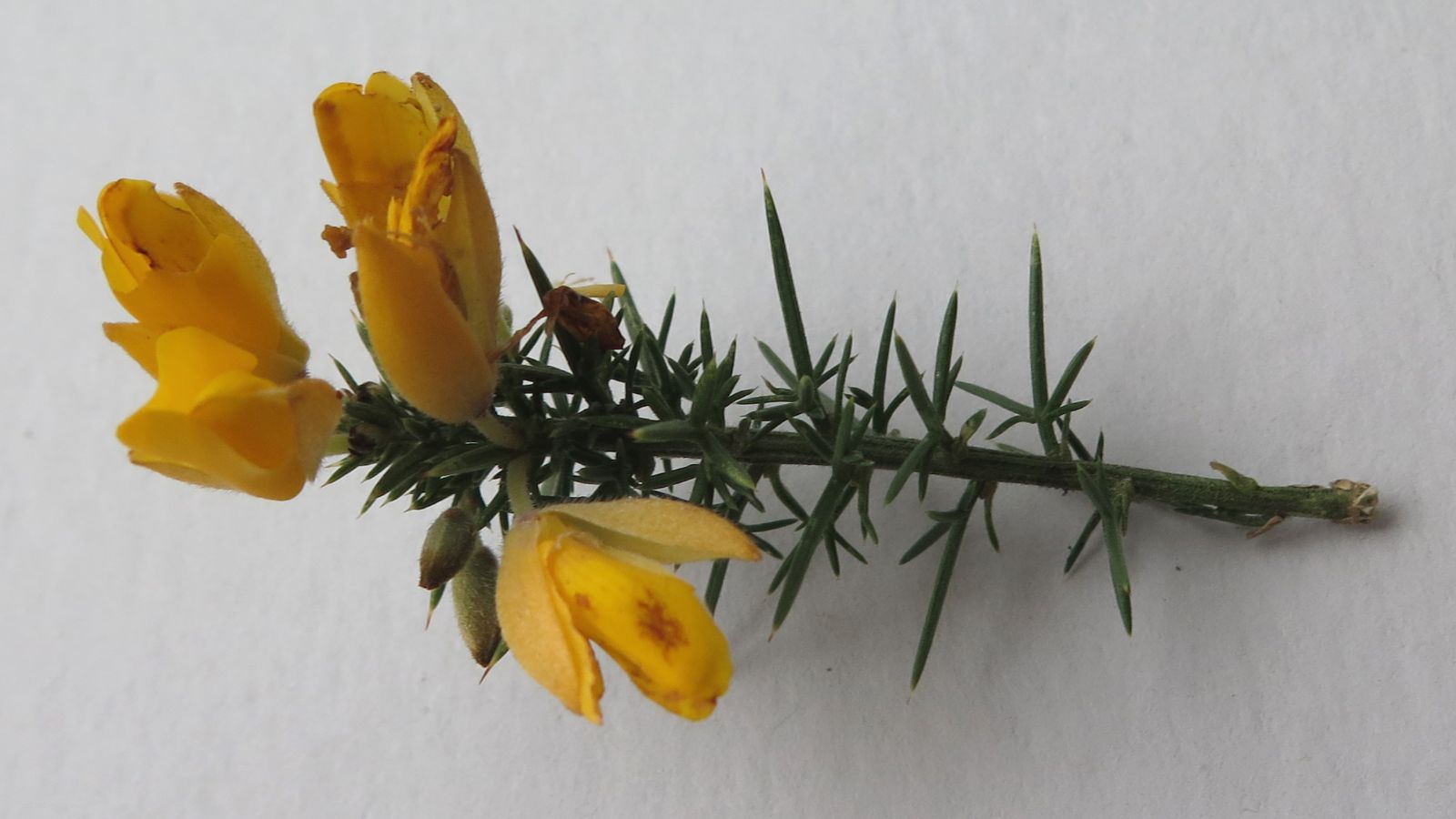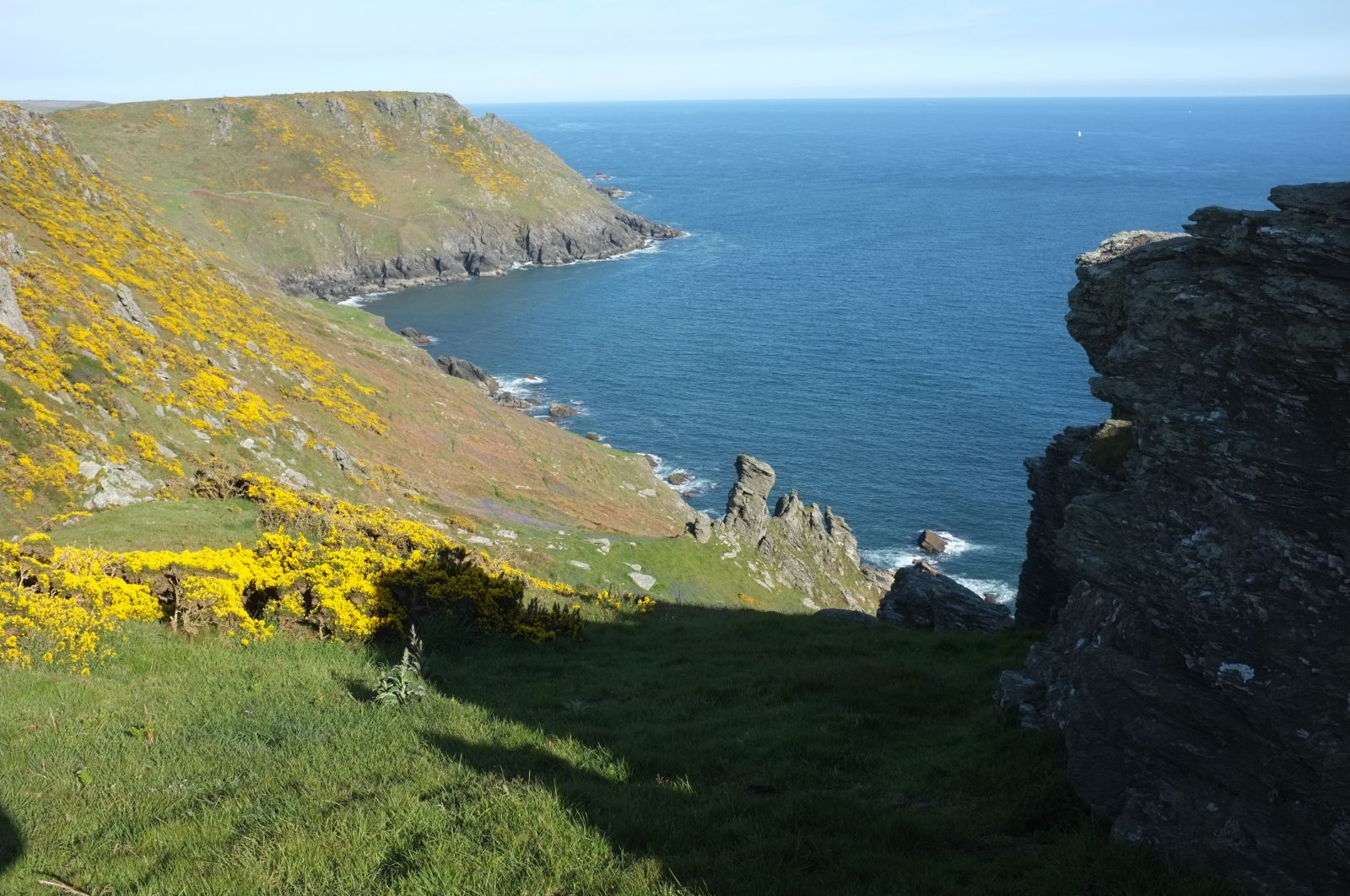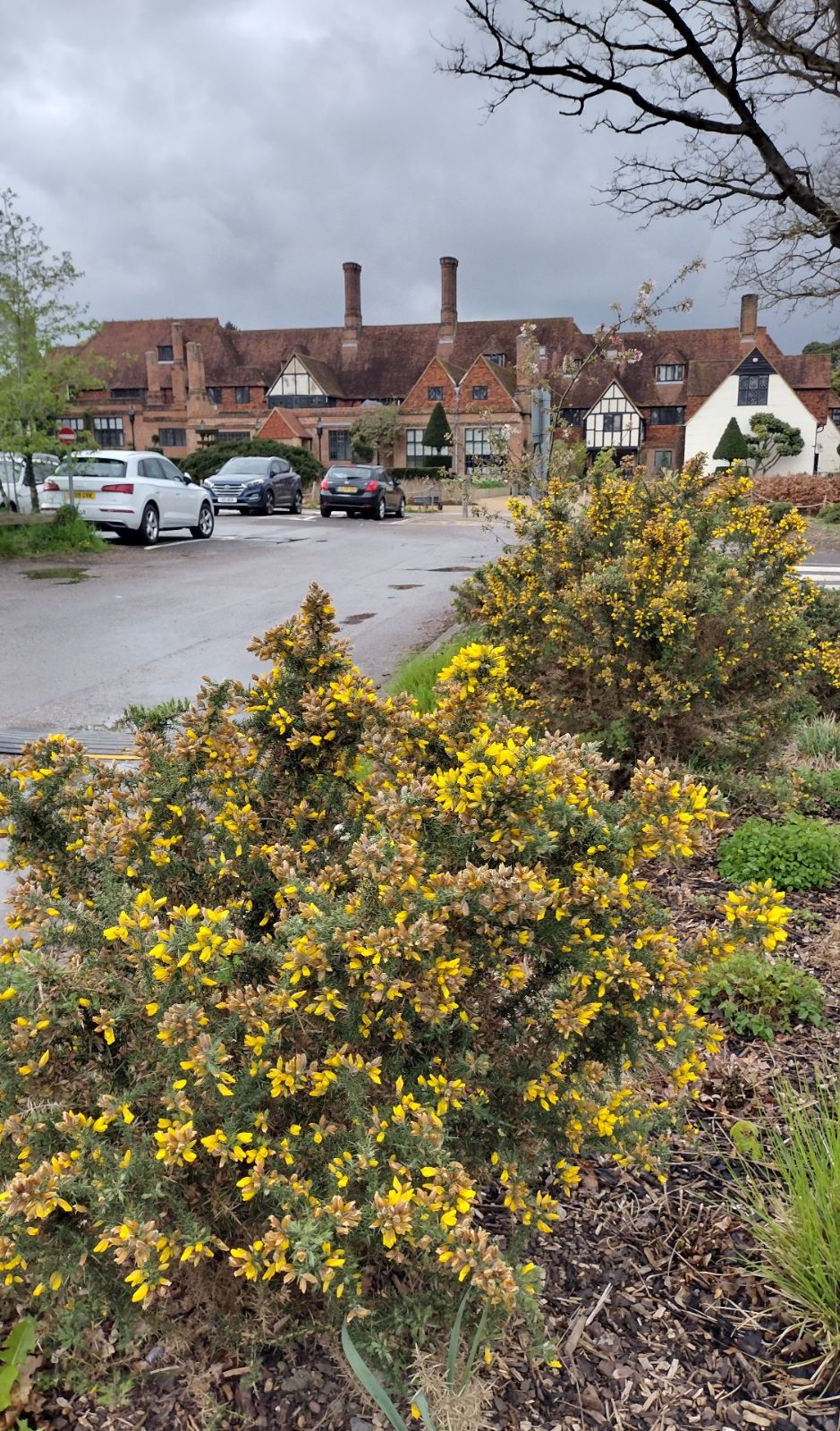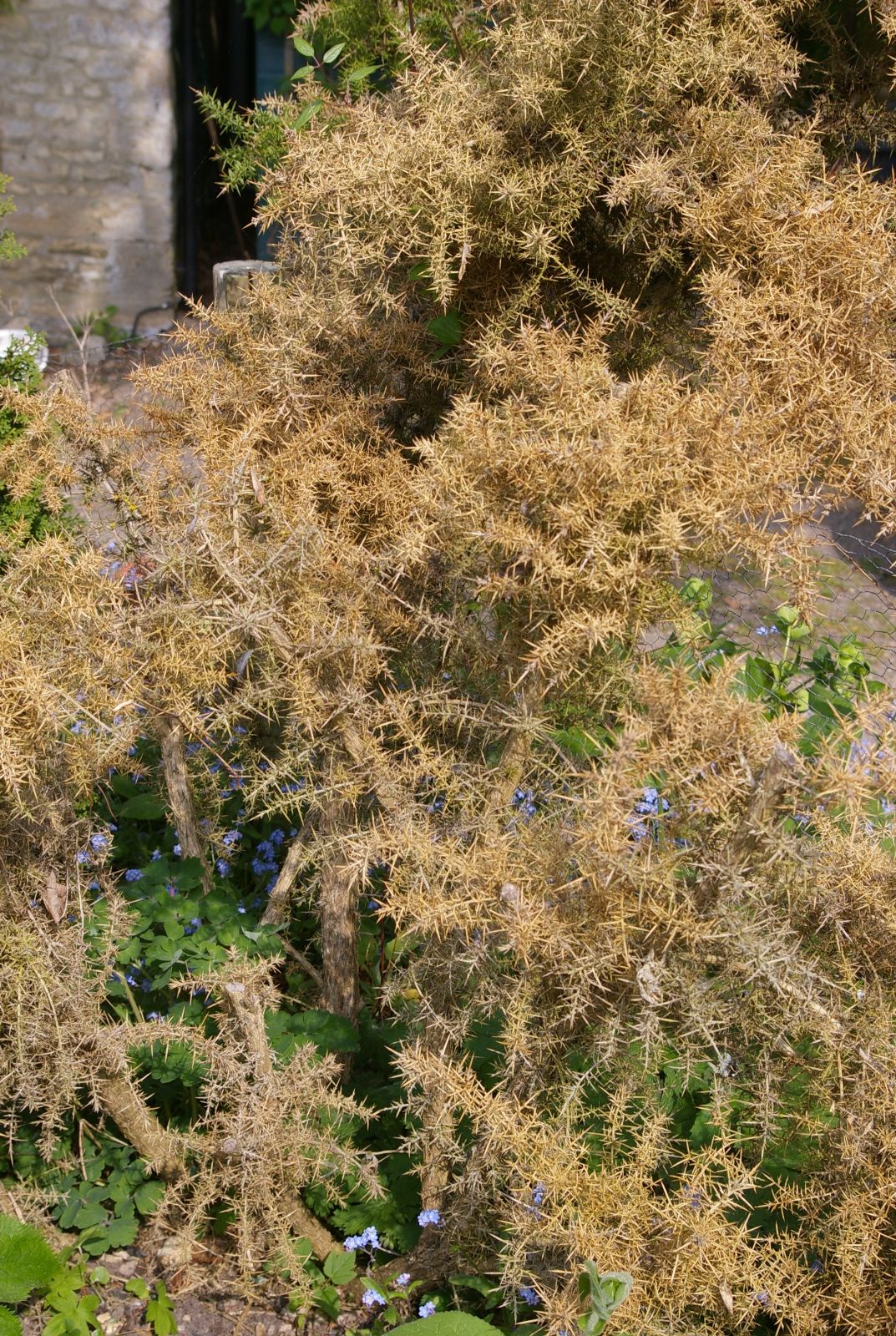Ulex europaeus
Sponsor
Kindly sponsored by
a member of the International Dendrology Society
Credits
Julian Sutton (2022)
Recommended citation
Sutton, J. (2022), 'Ulex europaeus' from the website Trees and Shrubs Online (treesandshrubsonline.
Genus
Common Names
- Gorse
- Furze
- Whin
Infraspecifics
Other taxa in genus
Shrub to 2.5 m, erect to prostrate. Young branchlets with both long, spreading and short, appressed hairs. Primary spines to 4 cm, straight or slighty curved, their branches often clustered towards the base. Primary phyllodes 5–12 mm, linear-lanceolate to triangular, rigid, spine-like. Bracteoles (1.5–)2–3(–3.5) × (1.5–)2–3.5(–4) mm, ovate to ovate-lanceolate, apex acute or subacute, base truncate; pedicel 3–13 mm, hairy. Calyx (10–)11–16 mm, with thick, patent hairs; upper lip 3–6 mm wide. Corolla with banner and wings longer than the calyx; banner 14–21 × 10–15 mm, glabrous; wings 14–21 × 3–6.5 mm, longer than the keel; keel 11–15 × 4–6 mm. Fruit 10–20 × 5–7 mm, ovate-oblong or obovate, with 2–8 seeds, hairy. Seeds 2.3–2.8 × 2–2.4 mm. 2n=96 (hexaploid). (Cubas 1999).
Distribution Belgium France Germany Ireland Italy Netherlands Portugal Spain Switzerland United Kingdom
Habitat Heathland, moorland, grassland, open woods, hedges and thickets; mostly on acidic to neutral soils, 0–1300 m asl.
USDA Hardiness Zone 6-9
RHS Hardiness Rating H6
Conservation status Least concern (LC)
Ulex europaeus is the most widespread and familiar Ulex species, and has an interesting history of economic use. As a garden plant it rides a fine line between gloriously ornamental flowering shrub and prickly, invasive, somewhat frost-susceptible horror.
This species has the potential to make a larger shrub than any other Ulex species, although that potential is not always realized. Its two most clear-cut identification features are the wings unambiguously exceeding the keel (versus shorter or about equal in all other species) and in the bracteoles being at least 2 mm wide (versus 1.5 mm or less) (Cubas 1999; Tutin et al. 1968). The widespread type subspecies (that which proves so invasive) is at least normally hexaploid, while subsp. latebracteatus is tetraploid. Despite occasional claims of diploids or tetraploids in subsp. europaeus, Cubas (1999) seems confident in the correlation between morphology and ploidy. There is molecular evidence that var. europaeus is an allohexaploid, that is it derives from polyploidy following an ancient hybridization event, bringing together multiple genomes (Ainouche et al. 2009 fide Hornoy et al. 2013; Fonseca et al. 2021). Indeed, it may contain genomes from three distinct branches of Ulex diversification (Fonseca et al. 2021).
An outbreeding species, Ulex europaeus is self-incompatible and requires pollination (probably usually by bees) for seed set, in both indigenous and invasive alien populations (Atlan et al. 2015). It is a famously long-flowering plant. In the British Isles peak flowering is in spring, but some individuals may be found with at least a scattering of flowers any month of the year. An English saying exists in several similar versions: ‘kissing’s out of fashion when gorse is out of bloom’ – that is, never. Some introduced populations in the Southern Hemisphere have two distinct flowering seasons (Broadfield & McHenry 2019).
Gorse has a strong relationship with fire. It is particularly flammable, partly due to the retention of old, dry spines beneath the outer clothing of green shoots. This makes it a quick-burning fuel ‘suitable for heating ovens, getting up a fire in the morning, or burning heretics’ (Rackham 1986). It was widely used in the British Isles and Brittany, especially in bread ovens, as well as lime and plaster kilns (Atlan et al. 2015). In Brittany briquettes made from cow dung and chopped, dry gorse were used as fuel, and alkaline gorse ash has been used as lye in both France and Britain (Loudon 1844). However, gorse’s flammability makes planting it where fire could endanger buildings or trees unwise (Bean 1981). It can regenerate vegetatively after burning, and fire stimulates seed germination (Atlan et al. 2015).
Despite – in some ways thanks to – its fearsome nature, Gorse had traditional uses across its native range, not merely as fuel. While these have largely died out, there is renewed interest in making use of what is otherwise a problem plant (Iyer et al. 2021). A nitrogen fixer, gorse has a high protein content (about 12% of dry mass – Iyer et al. 2021) and makes valuable animal fodder. Goats and sheep will graze it directly, but it has to be harvested and prepared for horses or cattle; in Britain, dedicated gorse crushers were at one time available (Bean 1981). It was sometimes field-grown in Brittany, Portugal and N Spain (Atlan et al. 2015; Cubas 1999), and Bean (1981) describes how in the British Isles cereals were sometimes undersown with commercially available gorse seed, forage being harvested in the second autumn, and alternate years thereafter. Its robust, springy structure made it useful in cattle bedding, while it makes stockproof, wind resistent hedges in exposed areas, and was sometimes woven into hurdles (Atlan et al. 2015; Bean 1981). In fox hunting areas of England it was at least tolerated as cover for foxes, as referenced in Saki’s darkly comic 1912 short story ‘Esmé’ (Munro 1982). One minor use is suggested by the enticing coconut-like aroma of the flowers, which have been used in Britain to flavour country wines (Berry 1987). Gorse has been used as a clan badge – a sprig of a specific plant worn in the hat, supposedly to aid recognition of fellow clan members – by (perhaps rather unhelpfully) several Scottish clans (Adam 1908).
Ulex europaeus is by any reckoning an invasive species, rated among the world’s 100 worst (Lowe et al. 2000). Established on oceanic islands as well as every continent apart from Antarctica, it has been introduced deliberately for agricultural use or ornament, and accidentally through seeds in soil. It has been used for hedging in both Canada and New Zealand, for example (Clements, Peterson & Prasad 2001).On his visits to St Helena in 1771 and 1775, James Cook found it already well established, introduced by settlers for fodder and shelter (Loudon 1844). It is now found from the equator to cold temperate regions, but thrives best without extreme heat or cold, and where annual rainfall lies between 500 and 1500 mm (Broadfield & McHenry 2019). Several traits contribute to this alarming status – broad ecological niche, high reproductive output from a young age, low susceptibility to pests, long-lived buried seed bank, potential for evolutionary change – and success has been linked to its polyploid genome (te Beest et al. 2012). Control measures have included burning, herbicides and biological control (a wide range of seed- and foliage-feeding insects have been tried), all with limited success and often resulting in conditions which favour re-establishment from the seed bank. Mechanical methods are effective but tend to promote soil erosion (Broadfield & McHenry 2019).
Visitors to Western Europe are often impressed by Gorse’s floral display: Loudon (1844) reports that the German botanist Jacob Dillenius on first visiting Britain fell to his knees on Hounslow Heath, London, at the sight. As a garden ornamental it was quite highly rated in 19th century Britain, Robinson (1898) recommending it for dry banks, among other flowering shrubs. Loudon (1844) suggested it as ornamental hedging, best planted on a low bank and clipped annually, or as shelter for newly planted trees. Both these authors, however, promoted the sterile double-flowered ‘Flore Pleno’ as superior to the wild type, and it is this that is usually planted today, except in the wilder margins of large gardens on light, acidic soil. These conditions along with more or less full sun and absence of extreme frost define its garden niche. Extremes of cold certainly cause death of aerial shoots; the plant regrows from the base but repeated exposure is probably what limits its range in Central and Northern Europe, and at altitude even in Northern Britain. To plant it beyond its natural range would be foolish, given its invasiveness; it is essentially unknown in North American gardens, and should probably remain so.
The cultivars listed below include no colour variants. Gerard (1597) mentions a white-flowered form originating in northern England, but this was already thought lost by Loudon (1844). Pale yellow variants, prized in so many in other yellow legumes, are apparently vanishingly rare. Both gardening botanist John Grimshaw and novelty-hungry nurseryman Joe Sharman have independently kept an eye out for them for many years, without ever seeing one (pers. comms. 2022); the author’s experience is similar. However Dot & Terry Underhill found just such a plant in a Cornish road cutting in the 1980s. Propagated from cuttings, they attempted to distribute it. Astonishingly they found no interest and planted them all in their Devon garden; the last died recently (D. Underhill pers. comm. 2022).
Hybrids with U. gallii are found where their ranges overlap. They are variable, intermediate and fertile (Stace, Preston & Pearman 2015). The name U. × breoganii has been used for them, but this confusing epithet is sometimes alternatively applied to forms of U. gallii (q.v.).
'Flore Pleno'
Common Names
Double Flowered Gorse
Synonyms / alternative names
Ulex europaeus 'Plenus'
Awards
AGM
Flowers semi-double, with some or all stamens replaced by petaloid organs of varying size. As seen today it is relatively slow growing and compact, to about 1.5 m height and spread, and appears more densely and longer flowering than typical U. europaeus; it seems to set no seed (Bean 1981; Edwards & Marshall 2019). Known since the early 19th century, Loudon (1844) believed it to have been collected from the wild in Devon by 1825; it was in John Miller’s Bristol nursery by about 1828 (Bean 1981). Today this is one of the most widely planted gorses in European gardens, along with U. gallii ‘Mizen Head’. It is entirely possible that more than one similar clone has existed under this name; indeed Loudon (1844) describes a plant in his Bayswater, London garden reaching 2.5 m height and 1.8 m spread within 5 years, which would be exceptional in the plant as grown today. Other named double cultivars have occasionally been mentioned, including ‘Irish Double’.
As with normal Ulex europaeus this is not hardy through long intensely cold periods – a plant in John Grimshaw’s garden at Colesbourne, Gloucestershire was killed by the extended freeze of December 2010, when temperatures remained below –10°C for over a week, and dipped to –15° (pers. comm. 2022).
'Strictus'
Common Names
Irish Gorse
Irish Furze
Synonyms / alternative names
Ulex europaeus 'Fastigiatus'
Ulex europaeus 'Hibernicus'
Erect, almost columnar growth, 2–3 m tall, with thin stems and weak spines; it flowers sparsely and is of little ornamental value, though it was sometimes used for hedging in the past. Found in the early 19th century on the Mount Stewart estate, Co. Down, N. Ireland by John White, under-gardener at the Dublin Society Botanic Gardens, Glasnevin. The common name was always ambiguous since ordinary U. europaeus seed imported to Britain from Ireland was at one time sold as ‘Irish Furze’ (Bean 1981, Nelson 2000). Loudon (1844) mentions that being less spiny, this plant – or something very like it – was at one time grown in Wales as a fodder crop, despite the need for vegetative propagation. In 1835 it was being used as a ‘splendid’ hedge at Knaphill Nursery, Surrey (Loudon 1844). Very uncommon ntoday, it is recorded as still being grown at Glasnevin (National Botanic Gardens 2022).
subsp. latebracteatus (Mariz) Rothm.
Differs primarily in its bracteoles being larger, (2–)3–5.5(–6) × (3–)3.5–7(–7.5) mm, ovate, suborbicular, cordate or reniform, their apices subacute, obtuse or truncated at the apex. 2n=64 (tetraploid). (Cubas 1999).
Distribution
- Portugal – N & C
- Spain – NW
This tetraploid plant has a much narrower range than the familiar subsp. europaeus, and is barely – if at all – in cultivation.













